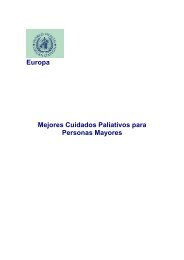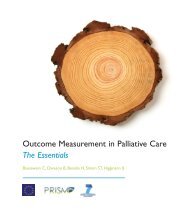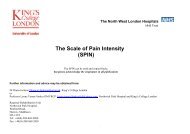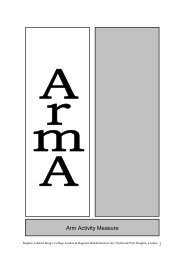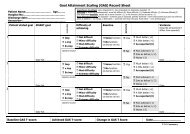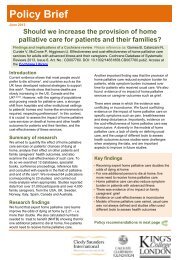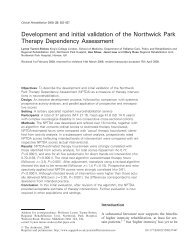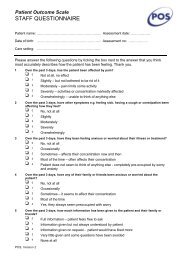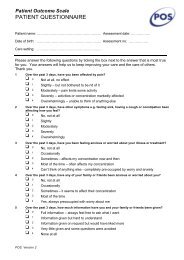The Rehabilitation Complexity Scale - King's College London
The Rehabilitation Complexity Scale - King's College London
The Rehabilitation Complexity Scale - King's College London
- No tags were found...
You also want an ePaper? Increase the reach of your titles
YUMPU automatically turns print PDFs into web optimized ePapers that Google loves.
Lynne Turner-Stokes, Rebecca Disler and Heather Williamson the more complex cases unless there are arrangements inplace to ensure adequate reimbursement, and this poses thethreat of discrimination to an already vulnerable and needygroup of patients.<strong>The</strong> National Definition Set for Specialised Services in BrainInjury and Complex <strong>Rehabilitation</strong>, defines three levels ofservice in neurological rehabilitation (Fig 1): 71 Local general (LG) rehabilitation services which are nonspecialistservices mainly provided at primary care trust orcommunity team level.2 District specialist (DS) services – usually a consultant-ledservice covering a population of 300,000–500,000.3 Complex specialised (CS) services – tertiary or regionalservices providing for people with more complexrehabilitation needs – usually serving a population of1–3 million.It is the latter group which have been earmarked for ‘specialisedcommissioning’, according to the Warner Report. 2<strong>The</strong> UK network of neurological rehabilitation servicesincludes both CS and DS services. <strong>The</strong> distinction is blurred,however, because, in some areas, the DS services have developedto a level where they have many of the same facilities and cantake on quite complex cases, albeit in smaller numbers than theCS services. <strong>The</strong> problem is confounded by the fact thatrehabilitation is only included in the Department of Health’scurrent health coding system (ICD 10 codes) as additional‘z codes’ which are rarely reported in practice, and so almost noinformation exists centrally on which to base tariff costs forrehabilitation.To date, HRGs have been developed only for inpatientservices. <strong>The</strong> HRG set for rehabilitation (version 4.0) specificallyexcludes CS rehabilitation. According to the National DefinitionSet, this would exclude CS services, but not DS services, fromthese HRGs. <strong>The</strong> Expert Working Group for HRGs in rehabilitationtherefore endorsed the current HRG set with the provisothat further work be done to develop a transparent system todetermine banded tariffs for different levels of complexity, andto define CS services in terms of demonstrated service deliveryat the complex end of the spectrum.<strong>The</strong> <strong>Rehabilitation</strong> <strong>Complexity</strong> <strong>Scale</strong> (RCS) (Appendix 1) hasbeen designed to provide a simple classification of case mix interms of rehabilitation inputs provided. It was developed tostand alongside the new rehabilitation HRGs to provide verysimple coding information with regard to complexity that couldinform tariff banding in district and general rehabilitationsettings. If there are differences in case mix between DS and CSservices, however, one would expect it also to be sensitive tothese.<strong>The</strong> aims of this study were:• to identify any service characteristics that distinguishinpatient CS neurorehabilitation services from DS servicesin the UK• to explore utility of the RCS and to determine whether itcould be used to identify differences in the case mix of thetwo types of service.MethodsStudy designA cross-sectional survey of consultant members of the BritishSociety for <strong>Rehabilitation</strong> Medicine (BSRM), the principalprofessional society for doctors specialising in rehabilitationmedicine in the UK, was conducted by postal questionnaire.Service characteristics of a complex specialisedrehabilitation serviceProposed defining characteristics for complex specialised rehabilitationservices were drawn from the National Definition Setnumber 7. 7 A questionnaire was drafted to include the following:• Definitions of the different service types were given andrespondents were asked whether they considered theirinpatient neurological rehabilitation service to be a CSservice, a DS service or a LG service.• Details were requested about their service, including thenumber of beds, staffing levels in different disciplines, andapproximate length of stay (LOS). Also about anyreduction in bed capacity in the last two years.• Respondents were asked to tick service characteristics,facilities and procedures on a checklist, and to add anyother features which might distinguish a CS service.<strong>The</strong> questionnaire was approved by the BSRM Research andClinical Standards Committee. Following piloting in 10 centres,it was sent out to all consultant members of the BSRM. Thosenot involved in providing neurological rehabilitation serviceswere asked to indicate this and return the questionnaire. Wherea service had more than one consultant, respondents were askedto collaborate with colleagues to provide a single response.Those working in more than one centre, however, were invitedto provide a response for each service.Exploratory use of the RCS to examine case mixdifferences<strong>The</strong> RCS is a 15-point measure made up of four differentsubscales:• C: basic care and support needs (range 0–3)• N: nursing interventions (range 0–3)• T: intensity of total therapy intervention (range 0–6)• M: medical intervention (range 0–3).It should be reported in a manner analogous to the GlasgowComa <strong>Scale</strong>, eg RCS 7 (C2 N1 T3 M1).Consultants were asked to apply the RCS in a single snapshotcross-sectional survey of their current inpatient caseload during asingle week, and also to provide feedback about the scale,including: how easy it was to apply; whether or not they thoughtit was useful in distinguishing more complex cases; and whetherthey would be prepared to apply it on a regular basis to informcosting tariffs. <strong>The</strong>y were also asked to provide general qualitativecomment and feedback.594 Clinical Medicine Vol 7 No 6 December 2007




